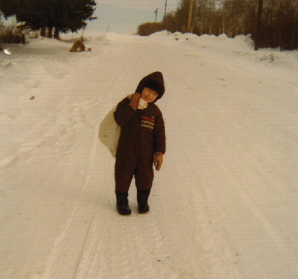
I WAS IN FINLAND for one month over Christmas, and then they settled the lockout. The NHL ended up playing a 48-game schedule that year.
I got a phone call from Graham James. When the Moose Jaw Warriors fired him in 1985, he went to Winnipeg and coached a Tier II team there for a year. Then the Swift Current Broncos hired him as their head coach. Both times, Sheldon Kennedy followed him. As I understand it, when Sheldon left Swift Current in 1989, Graham fell apart. Things started going a little crazy for him. He got careless, getting more boys involved. One of the Broncos, who would eventually join Sheldon in charging Graham with abuse, punched him in the nose during a game. In 1994 Graham James was told to leave Swift Current and not let the door hit him in the balls as he backed out.
Anyway, Graham knew I was doing pretty well financially. When I was sixteen, Len Peltz, who was like a second father to me, wrote a letter to a well-known Winnipeg lawyer-turned-agent named Don Baizley, trying to get some advice about what I should do. Len is a very smart, resourceful kind of guy. He’s one of the smartest people I have ever met—you play Trivial Pursuit with him, you never get a turn. Anyway, Don answered Len, and when it was time for me to be drafted, Don came on board. Don was always creative with contracts. The whole time I was with him, I never had a contract dispute. He made sure I was not a guy who went in and tried to renegotiate. Don always made it very clear to me that you should honour your contract—play it out and then move on to the next one. My first contract with the Flames ran for three years, from 1988–89 through 1990–91, and it paid $90,000 the first year, $125,000 in the second and third years. On top of that, I’d received a $65,000 signing bonus, and a bonus for games played that first year got me to $110,000.
In 1987–88, my last year of junior, I played for Moose Jaw until the team was eliminated from the playoffs. The Warriors worked out a trade for me, to Medicine Hat, who ended up winning the Memorial Cup that year, but the Flames told me that as soon as my season was over in Moose Jaw, I was going to Salt Lake. That was more appealing to me than staying in the Western league. I wanted the quickest route to the NHL, so I signed my pro contract right after we won gold at the World Juniors
I did go to Salt Lake, where I played in two regular-season games, racking up seven points. According to my contract, I could play only ten games, including the playoffs. Any more than that and 1987–88 would be considered the first year of my pro contract. I played in eight playoff games and got 7 goals and 5 assists. We won the Turner Cup, the league championship.
In the third year of the deal, I scored 50 goals, which made me look extremely valuable. The big money hadn’t hit yet: the second contract was for four years, at an average of $325,000 per year. After two years, however, I was allowed to renegotiate. I did, and that is when I signed my first big deal. Don Baizley negotiated five years for $12.4 million U.S., or $18 million Canadian. I sat out training camp to get it. At that point, I was one of the best players in the game. The Flames were cheap, but without me they knew they did not have a season. It was not all about money. It was also about competing and being the best I could be. I loved Calgary. I’ve always loved it. That is why I am back there today. The Flames gave me my shot, and for that I was extremely loyal despite what was going on. Let’s be honest: if it weren’t for me being the player I was, who knows if the team would still be in this city today?
WITH THAT SECOND CONTRACT I had more money than I knew what to do with. I had bought a house for Shannon and Josh and supported my parents. I was getting some good advice from Dave Stinton, a money manager recommended to me by Tom and Debra Mauro, friends of mine who owned Albi Homes. They helped me through a lot of tough times. Dave had me in secure investments—long-term stuff. I trusted Dave, but I had never had money and wasn’t too sure about what to do with it. I was ripe for an “opportunity.”
Which brings me back to Graham’s phone call. “What do you think about putting a WHL team in Calgary?” he asked.
Calgary had tried bringing the Western Hockey League to town twice before, in 1966 with the Centennials, then in 1977 with the Wranglers. But it seemed that cities that had an NHL team just couldn’t sustain a WHL team too. After ten years, the Wranglers moved to Lethbridge and became the Hurricanes.
I didn’t tell him to go fuck himself, and it took me a long time to understand why. I guess I felt that, when dealing with Graham, it was a matter of survival. While I was writing this book, I had it explained to me in a way that made a lot of sense by a psychiatrist named Dr. Robin Reesal. He used cannibalism as an example. He said there isn’t a person that would say it’s acceptable, yet we have heard stories about plane crashes in remote areas where what is normally thought of as wrong is cast aside for the sake of survival. For someone who has been abused, one of the hardest things to learn is that you can go against your abuser and still survive. I know that now. I wish I’d known it then.
Yeah, in the back of my mind I was thinking about the abuse, but it was like when a Catholic Mass starts and there are six hundred people in the building and a couple of new altar boys beside a dirty priest. Chances are there are twenty or thirty guys sitting in the pews who feel pretty bad that they don’t have the energy or the strength to talk to those altar boys or their parents about their history with that priest. I didn’t consider myself a victim. I blamed myself and thought I had made a stupid, weak choice. I guess I figured that each one of those kids on the hockey team had a chance to make their own choice or to stop it like I did.
I think I believed that I would die as a person if I had to go back and be vulnerable again. Money and position were my protection, and I knew that if I talked about the abuse in public I might lose everything. You might be reading this and saying, “Well, you are writing about it in this book. You could lose everything now. What’s the difference?” The difference is I am not in the NHL anymore. I have a business, I have a life. I am more secure and I understand that this person cannot control my life. Would I do the same thing today? No. Why not? Because I am no longer trapped by my past. Where is the proof? I don’t drink or gamble or mess around in my marriage like I did before. I am not running. I have stopped running.
So when Graham called and said the time was right and that hockey was bigger than ever—in Calgary, especially, since we’d won the Cup—and asked if I wanted to invest in this new WHL team, he still basically had a hold on me. The way I thought, he could tank my career if he wanted. I rationalized that he was a really good coach and manager and that he could put a solid team together.
The team was set up so that there were no majority shareholders. We were all minority partners. We paid $650,000 for the franchise plus start-up costs, which amounted to about $850,000 over two years. I was first in, with a cheque for $125,000. Joe Sakic was next. Joe had also played for Graham. In fact, he was one of the players who survived that terrible bus crash that happened when I was in Piestany.

On my way to my first-ever hockey practice, with my skates in a pillowcase over my shoulder. Who knew this picture would define so much of my life?—cold and alone.
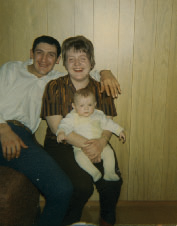
Wally, Donna and me. I look so innocent. I’m sure my parents never thought I’d grow up to be so much trouble.
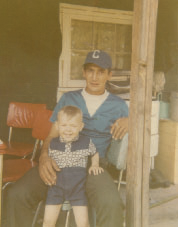
Wally Fleury and me at Williams Lake. My dad was a heavy drinker at one time. When I grew up and started indulging, he told me I could not drink what had rolled off the end of his chin.

The Russell Atom Team, otherwise known as “The Green Machine.” It looks like we should have done some fundraising for new uniforms!

Does this guy look destined for greatness?
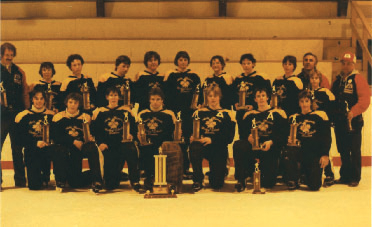
Another Manitoba Provincial B Championship with the Russell Rams. What a fantastic group of athletes and parents.

The behind-the-leg goal against the Regina Pats. (Believe me, I’m not always this cocky.)
REPRINTED WITH PERMISSION FROM ROY ANTAL/REGINA LEADER POST

Shannon and me at high school grad. Our son Josh was born eighteen months later.
COURTESY SHANNON GRIFFIN-WHITE

Ede and Len Peltz: integrity and class.
COURTESY EDE PELTZ

At the Calgary Flames training camp in Prague, 1989. Pilsner was ten cents a glass. That’s me in the middle of the second row from the back.

Celebrating my most talked-about goal. Game 6, Flames vs. Oilers, 1991.
REPRINTED WITH PERMISSION FROM GREG SOUTHAM/EDMONTON JOURNAL
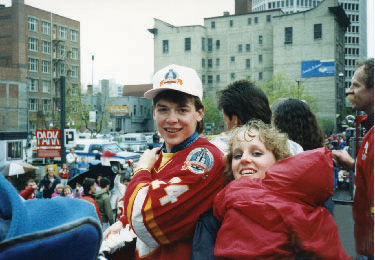
Shannon, Josh and me at the Stanley Cup parade in Calgary, 1989. I don’t know how the little guy slept through the whole thing.
COURTESY SHANNON GRIFFIN-WHITE

Me with “Killer” on a fishing trip in the Queen Charlotte Islands. Gilmour was the best centreman I ever played with.
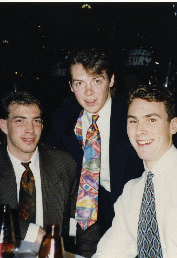
Joe Sakic (left), me and Trevor Linden. Super Joe was one of the best guys in the game.

With Gary Roberts (right), a great competitor.

One of the best things I ever slept with.
COURTESY SHANNON GRIFFIN-WHITE
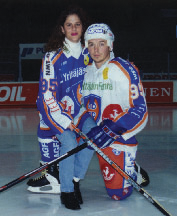
With Veronica at Christmas in Finland. Man, those Finns can really drink!
COURTESY VERONICA HAUGAARD
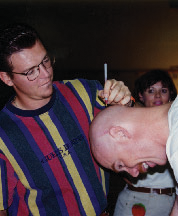
Signing Pete Montana’s head. He was a great teammate and a great friend.
COURTESY PETE MONTANA

One of our infamous after-season trips. Clockwise from left: Chuck Matson, Dwayne Roloson, Travis Fleury, Jamie Allison, Derek Morris, me (back row, centre), Wally Fleury, Cale Hulse, Chris Dingman, Jason Wiemer, Aaron Gavey, Todd Simpson, Joel Bouchard, Paul Naugaard, Jarome Iginla, Ted Fleury.
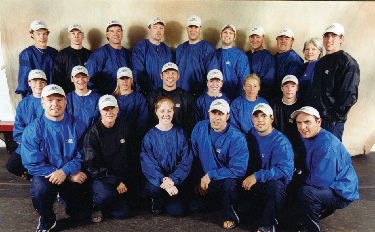
The hockey school gang: one of the best non-hockey teams ever assembled, with me (centre) as the leader, of course.
Sheldon put in $2,000 because Graham wouldn’t stop calling him about it. Altogether, Graham rounded up fifteen partners, including himself and John Rittinger. John and Graham were buddies in Swift Current and then in Calgary.
A few partners were players Graham had coached in Swift. Danny Lambert was one. He was a small defenceman, but super, super skilled. A great player and a nice kid. Tyler Wright was a kid from Kamsack, Saskatchewan, a winger. He was the Oilers’ first-round draft pick in 1991. Trent McCleary also played for Graham. His career ended after a freak accident during a game on January 29, 2000, while playing for Montreal. Chris Therien of the Flyers let go a slapshot and, when McCleary tried to block it by diving in front of it, the puck hit him in the throat. McCleary was rushed to a hospital and had an emergency tracheotomy. He was minutes from death. Then there was my buddy Tom Mauro, and Rusty James, Graham’s brother, who I knew really well. Rusty was also a good friend of Calgary Sun sportswriter Eric Francis. I don’t think Rusty knew about Graham. I hear they don’t speak anymore. Craig Highsinger was a guy I met in Winnipeg. He started out as a trainer for a Tier II team there and now he is the general manager of the Manitoba Moose.
Former NHLer Anders Hedberg was involved as well. Paul Charles too—he scouted for Moose Jaw and Swift Current, and then he became the head scout for the Hitmen. Now he works for the Minnesota Wild. Neil McDermid, a high-profile litigation lawyer in Calgary, was also on board. Graham got a couple of my ex-teammates involved as well. Bob Bassen was on the ice when I broke Al MacInnis’s team record for most points. Mark McKay, who was the captain when I played in Moose Jaw, was a great guy—small like me. He wasn’t the most skilled player, but he was a hard worker and a huge overachiever. He didn’t get drafted, so he went to Germany and became like a god there. He ended up getting his German passport and playing in two Olympics for them. He’s a player agent now—very successful. Lorne Johnson, a farmer, and his nephew, an oil and gas guy who would become my best friend, Chuck Matson, were among the businessmen who joined the ownership group.
And finally, wrestler Bret “The Hitman” Hart was involved. Bret Hart was supposed to put in $75,000, but at the last minute he changed his mind and wrote a cheque for $25,000 instead. He felt that his involvement in the team was worth the other $50,000. I really liked and trusted Bret but not the people around him. We licensed Bret’s wrestling name, agreeing to pay a percentage on the product we sold. We also used pink, which was Bret’s wrestling colour. That was an oxymoron—tough guys playing hockey with pink on their jerseys.
I told Pete I’d bought a Western Hockey League team. He looked at me and said, “Holy shit. Cool.” We made Pete our scouting coordinator. Graham would end up firing him because he was paranoid and didn’t want anyone I was close to on the inside.
Chuck Matson and I met at a couple of owners’ meetings and ended up visiting and talking. I think people pushed Chuck to try to strike up a friendship. Everyone saw that I needed more than my bar friends in my life, and Chuck was a really good businessman. A farm boy from Eston, Saskatchewan. Chuck broke his own rule, which is you don’t get into business with people you don’t know. Ever. But he thought it looked like so much fun, and he says he was mesmerized by all the “stars” who were going to be his partners. So before you know it, he’d thrown $50,000 in the hole without ever reading the partnership agreement. He says that the first time he looked out onto the ice and saw forty 16-year-old kids at camp, he thought, “Oh my God, what have I become involved with? Look at the responsibility and the liability.”
Chuck isn’t a big drinker, so when he and his wife, Elaine, became family friends with Veronica and me, most of the meals the four of us shared were at one of our homes rather than a restaurant. We had a private relationship, not a public one. But it was known that I really trusted Chuck. Even guys like Al Coates would call him and say, “Hey, how’s Theo doing?” Chuck and I had a mutual love for golf, and he sold his first company the summer after we bought the Hitmen, so he and I hit the links every single day. This irritated Veronica. She was already upset about the time I was spending away from her. But when I was home it was argue, argue, argue. Our relationship was up and down on a daily basis.
I was a kind of absentee landlord when it came to the Hitmen. I invested and went to a few meetings, but I really had nothing to do with the team on a day-to-day basis. The only decision I headed up as an owner was the logo design—we spent about thirty grand, and we came up with a Friday the I3th-inspired cartoon of a guy holding a hockey stick like a weapon, wearing a white hockey mask that looked like a skull. I knew it would sell. I loved it and thought it was unbelievable, but the logo didn’t go over with most of the press. They thought it was too violent.
Anyway, the Hitmen was a great name—it had multiple meanings. We decided to launch the logo at the Red and White Club at McMahon Stadium, where the Calgary Stampeders play football. Pete hosted and I was on the phone from Finland. Hockey Night in Canada’s Ron MacLean and Don Cherry flew into town just for the unveiling. If you know Ron, he is a really enthusiastic, sweet guy. He pulled off the white cloth and, ta daa … dead quiet. No applause, no cheering, nothing. For a minute I thought I had lost our connection. Then I heard a smattering of applause and thought, “This isn’t good.”
Local sportscaster Mike Toth, who went on to become an announcer for TSN and Rogers Sportsnet, went on the air that night on the local sports show on channels 2 and 7. Toth absolutely ripped the logo a new one. The next morning, Graham was tearing his hair out. “What the hell are we going to do?” So Pete had this idea to make the very first Hitmen jersey, and across the logo put one of those Ghostbuster circles with the diagonal bar through it. Then he put Toth’s name on the back, and the numbers “2 & 7.” Every Friday, all the sports media guys get together and play shinny. Pete used to play with them. He went into the dressing room and handed Toth this jersey in front of all the guys. He said, “No hard feelings. We know you will support the team regardless.” Toth was speechless. That night, he wore it on the air and he said, “I want to apologize for everything I said about the Hitmen. They are a classy organization.”
The public ate the logo up, but the Flames hated it! They said people were complaining that it was too violent and insisted we change it. The Flames were our landlords—we leased our space in the Olympic Saddledome from them—so they had a certain amount of power over us. We changed the logo to a couple of hockey sticks in a jagged, star-burst shape—sort of like a “pow” in the comic books. It sucked in comparison. Whatever the reason, when the Flames bought the team two years later, they reinstated the “Jason” logo.
I should have taken the whole thing as an omen. We had great hopes for the team, and when we started our first season in 1995–96, we thought we were going to beat everyone. We’d sold almost 1,500 season tickets and Graham had all of us investors pumped about the future. We ended up with an 18–51–3 record and a quarter-million-dollar loss. In 1996–97, ticket sales were only half what they were the first year.
But the shit would hit the fan while I was at the very first World Cup of Hockey in September 1996, playing the best hockey of my life.